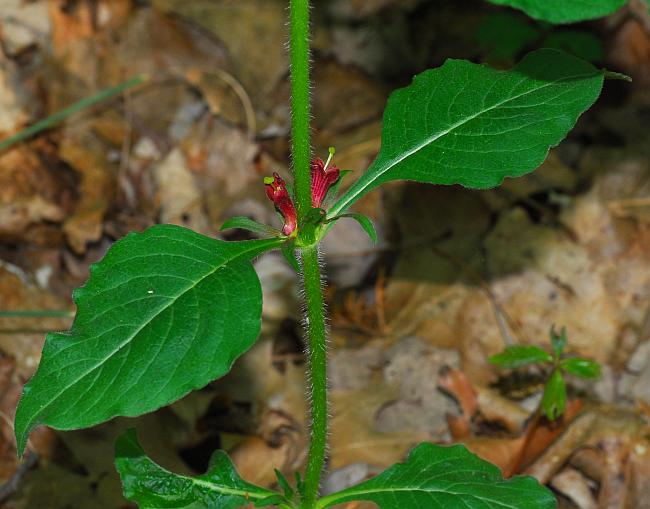Triosteum aurantiacum E.P. Bicknell
Red-Fruited Horse Gentian

Native
CC = 6
CW = 5
MOC = 43
© SRTurner
Triosteum aurantiacum E.P. BicknellRed-Fruited Horse Gentian | |
 |
Native CC = 6 CW = 5 MOC = 43 |
© SRTurner |
|
Family - Caprifoliaceae Habit - Perennial forb. Stems - Erect, to 1 m, moderately to densely pubescent with straight, more or less spreading, bristly, nonglandular hairs 1.0-2.0 mm long, these sometimes mixed with sparse, short (0.3-0.5 mm), softer hairs that are mostly minutely gland-tipped.
Leaves - Opposite. Leaf pairs not perfoliate or 1-3 median pairs weakly perfoliate, these 1-2 cm wide at the base. Leaf blades 9-20 cm long, 4-9 cm wide, oblanceolate to obovate or elliptic to fiddle-shaped, the nonperfoliate leaves tapered at the base, sometimes to an indistinct, broadly winged petiolar base, tapered to a sharply pointed tip, the margins with relatively dense, stiff, ascending hairs, the upper surface moderately pubescent with short, straight, appressed hairs, the undersurface moderately to densely pubescent with short, soft, spreading hairs mostly along the veins.
Inflorescence - Axillary, with 1 or less commonly 2 or 3 flowers per leaf axil (2-6 per node). Paired bracts subtending each flower sometimes longer than the ovary but shorter than the flower (including the calyx and corolla), linear to narrowly lanceolate. Flowers - Calyx lobes 8-15 mm long, the inner and outer surfaces with scattered, short hairs. Corollas 8-15 mm long, dull red to purplish red, narrowly funnelform, the mouth relatively strongly oblique, the outer surface with gland-tipped hairs. Styles not or only slightly exserted (less than 3 mm beyond the corolla lobes).
Fruits - Spherical, 7-10 mm in diameter, with persistent calyx lobes, red (orange when not fully mature), usually densely hairy at maturity.
Flowering - April - July. Habitat - Forests, bases and ledges of bluffs. Origin - Native to the U.S. Lookalikes - T. perfoliatum, T. angustifolium Other info. - This species is fairly common in the eastern 2/3 of Missouri, scattered or uncommon in the western regions of the state. Beyond Missouri it ranges across the northeastern quadrant of the continental U.S. and into Canada. Plants in this genus can be a little tricky to identify to species. Characters which point to T. aurantiacum include 1) leaves which are not strongly perfoliate but have relatively wide blades; 2) stem hairs which are long, spreading, and nonglandular; 3) sepals with non-ciliate margins. The flowers and fruits are usually red. The colloquial names for the horse gentians are somewhat unfortunate, since neither the flowers nor the fruits consistently comply with the color epithets. In addition, characters used in identification are variable and often show some overlap between species. It has been suggested that intermediate forms may represent hybridization events. Photographs taken at Cuivre River State Park, Lincoln County, MO, 5-9-2011, at Matson Hill County Park, St. Charles County, MO, 4-9-2012 and 5-12-2014, and at Glassberg Conservation Area, Jefferson County, MO, 7-10-2017 (SRTurner). |